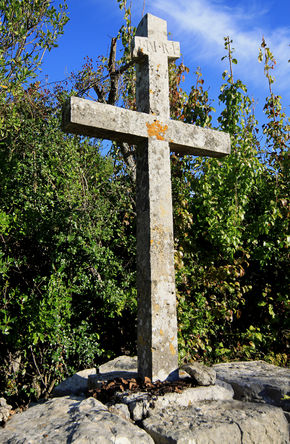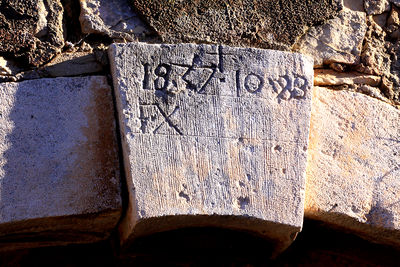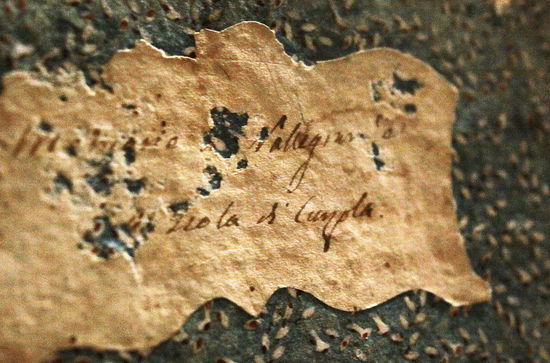Difference between revisions of "Directory:Zuvela"
(Franko Lemunada born 1795 had four sons) |
|||
| Line 277: | Line 277: | ||
===='''Franko''' Lemunada ==== | ===='''Franko''' Lemunada ==== | ||
| − | Franko Lemunada born 1795 had four sons: | + | Franko Zuvela - Lemunada was born in 1795 and had four sons (wife unknown): |
| − | * Ćoro was Franko | + | * Ćoro was Franko born 1828 (died 1909. Frank lived for 81 years. |
* Mede was Nikola b. 1830 (d.1899). Nikola lived for 69 years. | * Mede was Nikola b. 1830 (d.1899). Nikola lived for 69 years. | ||
* Lese was Ante b. 1833 (d.1900). Anton lived for 67 years. | * Lese was Ante b. 1833 (d.1900). Anton lived for 67 years. | ||
* Treće was Ivan b. 1835 (d.1918). Ivan lived for 84 years. | * Treće was Ivan b. 1835 (d.1918). Ivan lived for 84 years. | ||
| − | Franko Lemunada is | + | Ćoro, Mede, Lese and Treće became local clan names (start off as nicknames). |
| + | |||
| + | Franko Lemunada is descendent from Matij born 1670 in Blato, Matij who married Kata. | ||
====Are all Zuvelas descended from these individuals ?==== | ====Are all Zuvelas descended from these individuals ?==== | ||
Revision as of 09:37, 1 November 2021
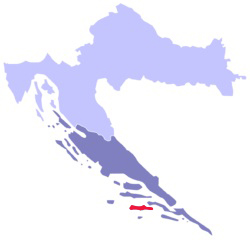
The Zuvela surname has strong roots originating from the western end of the island of Korcula in Croatia. Its original spelling was Xuvella. Another variation on the surname is Zuvella and Žuvela. In the Croatian language the Ž is pronounced as J in French 'Jacques', so Ž is zh.
The Zuvela’s Arrived on the West End of Korcula in the Early 1600s
The Zuvela’s arrived on the west end of Korčula (in Croatian the c in Korcula is pronounced ch and is written "č") in the early 1600’s and settled in a small field called Rasohatica. There are still small remnants of stone huts there to this day. First time the surname Xuvella was mentioned was in Blato in a document dated 2nd of February 1642.[1] At the time, Korčula was part of the Republic of Venice within the Venetian Dalmatia province[2] (Dalmazia Veneta or in old Venetian: Dalmàssia). From where the original Zuvelas migrated is still a mystery to this editor. The Republic of Venice [3] did have population movement within her eastern Mediterranean empire and did accept refugees and migrants within her boundaries during her long history. They came from all parts of Europe (i.e. Spain [4]). Many of them were Christians from the Ottoman Empire [5] which ruled the Balkans for centuries.
The Zuvelas abandoned Rasohatica and moved to live in the village of Blato. From there members of the Zuvela family moved to (and helped to establish) the town of Vela Luka. It is interesting to note that the Zuvelas by the 1690s had houses in the bay of Vela Luka (farm/work cottages in the bay or as per map of Korčula by V.M Coronelli 1688, warehouses of sardines and wine).
Zuvelas were engaged in sheep farming, construction and limestone klins. We have more; agriculture, fishing and seafaring just to mention a few occupations. They also liked to build on their land circular drywall cottages (locally Vrtujak also other names in the region; Kažun, Trullo, etc.).
In more modern times they have migrated to Australia as well as the United States and other parts of the world. According to 'The Statue of Liberty―Ellis Island Foundation Inc', one Zuvela Doda Marino in 1901 arrived in New York on the ship L Aquitaine.
The information concerning the early Zuvelas of Korčula is taken from a local 19th century historian from Blato called Nikola Ostojic (below):
He wrote a book about the town of Vela Luka in 1853. As we can see by 1853 Nikola Ostojic states that the Zuvelas had no origin stories/old memories (as he puts it), which means by the mid 1850's it was not know from where they came from. The family had been on Korčula for over 215 years and by then had lost their orgin history. The book was published in 1953 and was originally written in Italian (with a slight Venetian dialect).
During the time of the writing of Nikola Ostojic's book (Vallegrande nell' isola di Curzola), Italian was the official language of the Dalmatian province[7] at the time and had been so for centuries. In the late 1850s the Croatian language which was referred to as Illyrian[8][9] , was introduced by the Austrian authorities as a second standardised language within the Kingdom of Dalmatia (Konigreich Dalmatien, which was part of the Austro-Hungarian Empire). It then slowly replaced Italian altogether. Thus the surname Xuvella became Žuvela. From the late 19th century onwards the Dalmatian Italian culture has all but disappeared from the region. The last Italian language government school was abolished in Korčula on the 13th of September 1876.[10][11]
- Beginnings of Formal Education - Vela Luka states:
Below is information taken from the Vela Luka Primary School records. It mentions one Xuvella Giacobbo di Francesco:
- School year 1862./63.; III. r. [grade 3] Xuvella Giacobbo di Francesco [13]
Historically the mother tongue of the majority of the population of the island of Korčula (in particularly the west end) is old Croatian.[14] The Korčula dialect [15] of the local Croatian language acquired many influences over the centuries, such as the now extinct Latin Romance language Dalmatian,[16] Venetian and others. It has to be taken into account that some parts of the population were bilingual (or even multilingual).
EPIDEMIC of 1617
As we know in the early 1600s, the Zuvelas settled in a small field, Rasohatica, at the western end of the island of Korčula. Perhaps they were fleeing from the territorial conquest of the Turks that lasted for centuries. Even after the conquest of the Ottoman Empire (the Turks) many people wanted to escape, and some of it is well documented.
Pandemics were present and were part of the Levant’s main trade route. Before the arrival of Zuvela on Korčula, there was an epidemic and depopulation. This made a lot of new land available. Below information is from doctor Nikola Bačić 2007:
Taken from 'Plague Epidemic on the Island of Korcula 2007'.
Images
Zuvela Vrtujaks
There are circular dry stone buildings (Vrtujak/Rotunda/Trullo) on the island of Korčula in CROATIA which are mainly found in the west end of the island. There are around 10 of them in the region (according to Rada Dragojević Ćosović: Suhozidna arhitektura, vrtujci i torete otoka Korčule). Most were built by the Zuvela families (Vela Luka - Blato area). Locally they are called ‘Vrtujak’. The vrtujak term in the Croatian language references the circular nature of the structure. These unique architectural field stone houses seem to have been built in the 18th century during the Republic of Venice period and later in the 19th century (Lesetov Vrtujak meaning built by the Lese Zuvelas).
Other circular dry stone buildings which are near Korčula are in southern Italy (Trullo). They are in and around the town of Alberobello (in the province of Bari). They are also located in Istria, ‘Kažun’ in Croatia (and on the island of Brač where they are called Bunje or Kućice, and there are also some on Hvar, Trima)
New York Passenger Arrival Lists (Ellis Island) 1892-1924
In 1907 a young 18 year old Peter Zuvela arrived in New York. On the "List or Manifest of alien Passengers for the U.S Immigration Officer at port of arrival" his name is registered as Peter Ante Zuvela. Later for some reason it was change to Peter Zuvola. In the actual Immigration Manifest there is mention of another Zuvela, both were registered as Non Immigration Aliens.
Below info taken from familysearch.org.[17]
- Given name: Peter A...
- Surname: Zuvola
- Last place of residence: Vela Luka
- Date of arrival: 08 Mar 1907
- Age at arrival: 18y
- Ethnicity: Austrian, Dalmatian
- Port of departure: Trieste
- Port of arrival: New York
- Gender: Male
- Marital status: S
- US citizen:
- Ship of travel: Pannonia
Peter Ante Zuvela immigrated with his sisters Marija and Vica. In 1912 he married Marija Oreb (also from Vela Luka). They had 10 children and 37 grandchildren. Peter worked in the iron ore mines and on commercial fishing boats. In 1937 the whole family of 10 kids moved to Washington state (USA) and settled in Everett where he lived until his death in 1964. Back in the old country (Korčula), he would have been know as Petar Žuvela - Ante. Ante is a family Zuvela clan nickname.
New York Passenger Arrival Lists (Ellis Island)
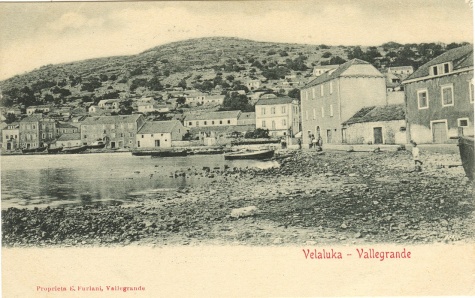
List from Korcula [18]:
The spelling is per the New York Passenger Arrival Lists of Ellis Island.
1. Doda Marino Zuvela - Curzola 1901
2. Kokot Vinc. Zuvela - Corzola 1901
3. Iroce Nicolo Zuvela - Vallegrande 1902
4. Petrun Antonio Zuvela - Vallegrande 1902
5. Antonio Zuvela - Vollegrande 1903
6. Geovanni Zuvela - Triest 1903
7. Luigia Zuvela - Velaluha, Austria 1904
8. Doda Zuvela - Velaluha, Austria 1904
9. Vincenzo Zuvela - Vallegrande 1904
10. Piotr Zuvela-Kroz..., Austria 1905
11. Giorgis Zuvela - Cuyola 1906
12. Marin Zuvela - Veloluka 1906
13. Petar Zuvela - Veloluka 1906
14. Ivan Zuvela - Blatto, Dalmatia 1910
15. Tote Zuvela - Blato, Austria 1910
16. Marko Zuvela - Blatto, Dalmatia 1910
17. Jerko Zuvela - Velaluka 1912
18. Yela Zuvela - Vallegrande, Austria 1914
19. Petar Zuvela - Raguse, Herzegov (USA) 1920
20. Mare Zuvela Grizim - Valegranda, Jugoslavia 1921 [19]
Additional Surnames Similar to Zuvella but not of Korčula Origins plus Zouvelos (Ellis Island)
- Athena Zouvella from Zakynthos, Greece 1922 [1].
Zouvella (modern Zouvela) from Zakynthos is the closest spelling to Xuvella. It is very probable that the Zuvela surname came from Zouvelos. The Greek source surname Zouvelos (Ζουβέλος), with the arrival of the Republic of Venice in Greece's coastal area, I assume that the old Venetian influence made it Zouvella. When the surname passed to Dalmazia Veneta (for example Korčula, southern Dalmatia, today part of modern Croatia) it was written as Xuvella. At the time of arrival of Zuvelas, a large population of Croats already lived on the island of Korčula. "Zo" was changed to X. Basically, old Croatian and more Venetian influences were added. X was sometimes used in the old Venetian-Italian language to write (modern) Žrnovo as Xernova, a small village on Korčula. The family name Žanetić was written Xacnich.
Additional
- Felippa Zavello Ianain 1892
- Angela Zavello Oddalengo, Oddalengo, Grande, Italy 1907
- Franceso Zavello 1922
- Emanuele Zivello Castelfranci, Italy 1910 [2]
Gallery-Zuvela Crosses and FX signature on the Island of Korcula
THE OLD (stare) XUVELLAs
Based on the records and information which are available to me, I have come to this conclusion written below. My research is largely based on the writings of Zvonko Maričić and Don Ivo Oreb plus Nikola Ostojic's original book (for viewing) and four 'Family Trees of the Zuvelas' that were kindly given to me.
CONCLUSION
The Zuvelas came to the Republic of Venice's, Dalmazia Veneta in the 1630s most likely refugees from Greece (Greco-Venetian original Zouvello modern Zouvela Greek: Ζουβέλα). They settled in the west end of the island of Korčula (previously also know as Curzola [20]). Temporary residency was set up in a small field called Rasohatica (previously know as Rasohatija). After that they moved to Blato (previously also know as Blatta).
Antonio Xuvella comes up in my research that is not recorded as being born on Korčula (not registered via church records of births). However Antonio (Antun) is mentioned in the town documents [21] and his record is the oldest which was in Blato dated 2nd of February 1642.
Antonio Xuvella (Antun) was probably the father of the Zuvela family because his generation (records wise) is older than the others. I have come to a conclusion based on family naming tradtions his wife may be called Jacquilin, Greek: Zaklín or Ζακλίν (Cro: Jaka). They had five sons and the first are written according to the historical original sources (the translation work is done by Don Ivo Oreb) and one being from Zvonko Maričić (ref 22):
1. Matteo (Matij)
2. Cosma (Kuzma)
3. Giacobbe (Jakov)[22]
4. Antonio (Autun)
5. Nicolo (Nikola)
In Don Ivo Oreb's work there are no dates of birth. His Croatian version is based on the source documents that are written in Venetian Italian.
The Newly Arrived Xuvella's Started Families
With the current data available.
1. Matteo/Matij had a son called Antun (Antonio) who was born in 1651 on Korčula. [23]
Antun (Antonio or Ante) then married Frana and they had five children (Matteo's grand children):
- Matij born 1670 (Matij married Kata)
- Marin 1675
- Ivan 1681
- Jaka 1683
- Nikola 1684
(Based on Zuvela Grizun's and Don Ivo Oreb's Žuvela family trees)
2. Cosma/Kuzma had a son called Ivan
(Based on Zvonko Maričić's work) [24]
3. Giacobbe/Jakov had a son Nikola
(Based on Don Ivo Oreb's Žuvela family tree and Zvonko Maričić's work [25])
4. Antonio/Autun had a son Marko
(Based on Don Ivo Oreb's Žuvela family tree)
5. Nicolo/Nikola had a son Jakov
(Based on Don Ivo Oreb 's Žuvela family tree)
There is another mystery Zuvela (Jerko) who is mentioned within the writings of Zvonko Maričić (p169) which is in 1705, Nikola of the late Jerka Žuvela.
Franko Lemunada
Franko Zuvela - Lemunada was born in 1795 and had four sons (wife unknown):
- Ćoro was Franko born 1828 (died 1909. Frank lived for 81 years.
- Mede was Nikola b. 1830 (d.1899). Nikola lived for 69 years.
- Lese was Ante b. 1833 (d.1900). Anton lived for 67 years.
- Treće was Ivan b. 1835 (d.1918). Ivan lived for 84 years.
Ćoro, Mede, Lese and Treće became local clan names (start off as nicknames).
Franko Lemunada is descendent from Matij born 1670 in Blato, Matij who married Kata.
Are all Zuvelas descended from these individuals ?
One has to ask, is it possible that the Zuvela families are all descended from the individuals mentioned above? It’s most likely true. We may also be looking at the original residents of Rasohatica and Blato!
Importantly the early Zuvelas in economic terms were no time wasters (wealth might have been brought with them). A Mr Antonio Xuvella in the 1640s was an owner of no less than 211 sheep. The Zuvelas moved to the near by village of Blato and bought, acquired houses and properties there, later land and properties acquired or bought in and around the bay of Vela Luka (previously also know as Vallegrande [26]).
For many centuries Romance Latin language called Dalmatian was the norm on the island. Later it was joined by old Croatian Chakavian language [27][28]. With time these languages started to overlap. By the time the Zuvelas arrived on the island the majority of the population of the island of Korčula (in particularly the west end) spoke old Croatian [29] with a mix of the Romance Dalmatian language [30] and with heavy influences of Venetian (lingua franca of that era). This is in essence is the old Korčula dialect.
So with time verbally Antonio would become Antun or Ante. It is quite possible later that both verbally Antonio and Ante were used with Antonio slowly disappearing from local language, a process of several centuries. Written language was a different story, Latin and Venetian Italian were the standard written language back then so Antonio still existed in written form. In 1797 the island of Korčula was no longer part of the Republic of Venice (dissolved by the French Empire: 1797). The last Italian language government school was abolished in the town of Korčula on the 13th of September 1876.
According to some sources todays Žuvelas are "the second most common surname in the Dubrovnik-Neretva County of Croatia ". Currently my thoughts on the actual word Xuvella as a surname was reinterpret with the Zuvelas arrival on the island in the early 1600s, which also signalled a new fresh start for the family.
See also
Notes and References
- ^ Vela Luka od 1490 do 1834 by Zvonko Maričić (p168)
- ^ John Everett-Healu. "Dalmatia." Concise Dictionary of World Place-Names. Oxford University Press. 2005. Encyclopedia.com
- ^ Note: In old Venetian 'Repùblega Vèneta' also know as La Serenissima
- ^ Dalmatia and Montenegro: With a Journey to Mostar in Herzegovina -Volume 1 by John Gardner Wilkinson (p116).
- ^ The Land of 1000 Islands by Igor Rudan Copyright © 2006 by the Croatian Medical Journal. All rights reserved.
- "However, the clashes between the Ottoman Empire and Venetian Republic produced extensive migrations from the mainland areas, especially from today's Bosnia and Herzegovina, to the eastern parts of the islands of Brac, Hvar, Korcula, and Pag."
- ^ Vela Luka-Historijsko Topografski Prikaz/Vallegrande nell' isola di Curzola by Nikola Ostojić Eng: Vela Luka - Historical Topographic View
- ^ Osnovna Škola "Vela Luka" Vela Luka Zbornik-150 Godina Školstva u Velaoj Luci (p12)
- ^ Osnovna Škola "Vela Luka" Vela Luka Zbornik-150 Godina Školstva u Velaoj Luci, (p.50) written in Croatian
- ^ Illyrian is taken from Illyricum which was a province of the Roman Empire. It was named after one of the indigenous peoples in that region. Please note it was later established that the Slavic Croatian language had nothing to do with the ancient Illyrian population of Europe.
- ^ The Italians of Dalmatia by Luciano Monzali (p83)
- ^ Editor's Note: In the neighbouring Kingdom of Croatia (within Austro-Hungarian Empire, Königreich Kroatien - Österreichisch-Ungarische Monarchie) a Croatian nationalistic movement was established and alongside that, within the Balkan region a Pan-Slavic movement was growing (the beginnings of the ill fated Yugoslavia). These political on goings started to be felt in the Kingdom of Dalmatia. The Austrians in the 1860s started to introduce (a process of Croatisation, Neo Shtokavian) within the Kingdom of Dalmatia a standardised Croatian language sometimes referred to as Illirski. It then replaced Italian altogether. In effect the government undertook culture genocide. For centuries the Italian language was the official language of the Dalmatian establishment. It was also the spoken language in white-collar, civil service and merchant families. For a few years Italian schools were still being run privately in the Kingdom of Dalmatia, i.e the city of Zadar and Split (Lega Nazionale at Spalato).
- ^ The Early Beginnings of Formal Education - Vela Luka (beginnings of literacy and Lower Primary School 1857 – 1870) (p.12 written in Croatian, part of Vela Luka Zbornik-150 Godina Školstva u Velaoj Luci)
- ^ Osnovna Škola "Vela Luka" Vela Luka Zbornik-150 Godina Školstva u Velaoj Luci (p50)
- The Early Beginnings of Formal Education - Vela Luka (beginnings of literacy and Lower Primary School 1857 – 1870):
- ^ Editors note: Recent DNA studies have stated that more than three quarters of today's Croatian men are the descendants of Europeans who inhabited Europe 13 000-20 000 years ago. The term Slav was first used by the Byzantines (i.e. Procopius-Byzantine scholar, Jordanes- 6th century Roman bureaucrat) and was recorded in the 6th century (c. 550) in Greek (Σκλαβῖνοι-Sklabenoi). Later in Latin it was written Sclaveni. Slavic tribes invaded the region of Roman Dalmatia in the early Middle Ages. Prior to the arrival of the Slavs, Roman Dalmatia was mainly inhabited by a Roman Latin-Illyrian population. The first primary source (factual-that its authenticity isn't disputed) to mention the Croatian-Hrvat identity in the Balkans was Duke Branimir (Latin: "Branimiro comite dux cruatorum cogitavit" c. 880 AD). Branimir was a Slav from Dalmatia.
- ^ NOTE: The local dialect is sometimes referred to as Naski or more correctly Naški. The š is pronounced sh.
- Sir John Gardner Wilkinson (an 19 century English historian. October 5, 1797 – October 29, 1875) was an English traveller, writer and pioneer Egyptologist of the 19th century. He is often referred to as "the Father of British Egyptology". He referred to the Dalmatian Slavic (old Croatian) as Illirskee. Cited from Dalmatia and Montenegro: With a Journey to Mostar in Herzegovina by Sir John Gardner Wilkinson. (p33)
- ^ Collegium Antropologicum, Volumes 15-16 by Croatian Anthropological Society-1991. (p311)
- ^ www.familysearch.org: Peter A... Zuvola
- ^ mainly referenced from https://familysearch.org/search/collection/results?count=20&query=%2Bsurname%3AZuvela~&collection_id=1368704
- ^ referenced from https://familysearch.org/ark:/61903/1:1:J6NH-PTP
- ^ Greek: Kórkyra Melaena or Κόρκυρα Μέλαινα, and Corcyra Nigra (Latin)
- ^ Vela Luka od 1490 do 1834 by Zvonko Maričić (p168). It mentions Antun who is not part of the Zuvela Korčula born family trees (or any family tree). This could indicate him as a Korčula island migrant arrival.
- ^ Info obtain via Zvonko Maričić's work. He writes "…. Jakovu [Giacobbe] Žuveliću of late Antun [Antonio] one small piece of land ..... ". Referenced from 'Vela Luka od 1490 do 1834' by Zvonko Maričić, page 168.
- ^ According to one of the Zuvela family tree Ante (Antonio) was born 1651 and is the son of Matteo/Matij. Matteo/Matij Xuvella is not part of the Zuvela Korčula family tree as being born on the island of Korčula.
- ^ Info obtain via Zvonko Maričić's work. He writes "…. or Ivan [Giovanni] son of the late Kuzma [Cosma] 22nd of December 1672". Referenced from 'Vela Luka od 1490 do 1834' by Zvonko Maričić, page 168. According to Zvonko Maričić, Ivan was a witness to a contract being signed in 1672 and his father was Kuzme. Kuzma is not part of the Zuvela Korčula family trees as being born on the island, this may indicate him as a migrant arrival.) Please note: It would seem that the old Xuvellas could read. We are looking at Old Venetian-Italian
- ^ Info obtain via Zvonko Maričić's work. He writes about Nikoli (Nicolo) Žuvela of the late Jakov (Giacobbe) regarding purchases of land. Referenced from 'Vela Luka od 1490 do 1834' by Zvonko Maričić, on page 168 and page 169.
- ^ Latin: vallem maximam
- ^ Smiciklas, CD V, (p237); N. Klaic, Povijest Hrvata u Razvijenom, (p130): "In 1262 the Venetian praised the Slavs and Latins on the island of Korcula for submitting to the prince Venice had sent." Note: What we can safely assume is that from the 13th century onwards there were two ethnic communities living on the island in the middle ages, one being descendants of the Roman Empire and the other being of Slavic descent. Further to the fact an community is needed to speak Dalmatian Latin in order for it be present.
- ^ When Ethnicity Did not Matter in the Balkans: by John Van Antwerp Fine. (p103)
- ^ Closely related to Chakavian of the 15th century. " ..... Chakavian dialects of western Croatia, Istria, the coast of Dalmatia (where a literature in that dialect developed in the 15th century), and some islands in the Adriatic. In those areas... " taken from http://www.britannica.com/EBchecked/topic/104539/Chakavian
- ^ Dalmatian-language:"Dalmatian language, extinct Romance language formerly spoken along the Dalmatian coast from the island of Veglia (modern Krk) to Ragusa (modern Dubrovnik). Ragusan Dalmatian probably disappeared in the 17th century; the Vegliot Dalmatian dialect became extinct in the 19th century" taken from http://www.britannica.com/EBchecked/topic/150247/Dalmatian-language.
External links
- Photo link for a aerial view of Korcula Town
- Korcula Info
- Trullo
- Paul Zuvella - former USA Major League Baseball player
- Natasha Zuvela - Australian TV Presenter, Speaker and Author
- Tony Zuvela - Australian cartoonist
- Domenica Žuvela a Croatian singer

Croatia Dubrovnik Neretva County Korčula Dalmatia Dalmatian Language Korcula History Korčula Vela Luka Blato Dalmatian Republic of Venice Venetian Natasha Zuvela Tony Zuvela Paul Zuvella Žuvela Peter Zuvela Petar Žuvela







